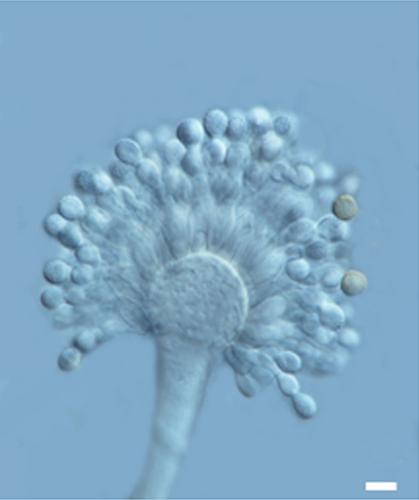当前位置:
X-MOL 学术
›
Lett. Appl. Microbiol.
›
论文详情
Our official English website, www.x-mol.net, welcomes your feedback! (Note: you will need to create a separate account there.)
Filamentous fungi with high paraquat‐degrading activity isolated from contaminated agricultural soils in northern Thailand
Letters in Applied Microbiology ( IF 2.4 ) Pub Date : 2020-12-30 , DOI: 10.1111/lam.13439 P. Wongputtisin 1 , C. Supo 1 , N. Suwannarach 2 , Y. Honda 3 , T. Nakazawa 3 , J. Kumla 2 , S. Lumyong 2 , C. Khanongnuch 4
Letters in Applied Microbiology ( IF 2.4 ) Pub Date : 2020-12-30 , DOI: 10.1111/lam.13439 P. Wongputtisin 1 , C. Supo 1 , N. Suwannarach 2 , Y. Honda 3 , T. Nakazawa 3 , J. Kumla 2 , S. Lumyong 2 , C. Khanongnuch 4
Affiliation

|
The contamination of paraquat (1,1'-dimethyl-4,4'-bipyridylium dichloride) herbicide from the farming area has become a public concern in many countries. This herbicide harms to human health and negatively effects the soil fertility. Several methods have been introduced for the remediation of paraquat. In this study, 20 isolates of the paraquat-tolerant fungi were isolated from the contaminated soil samples in northern Thailand. We found that isolate PRPY-2 and PFCM-1 exhibited the highest degradation activity of paraquat on synthetic liquid medium. About 80 and 68% of paraquat were removed by PRPY-2 and PFCM-1, respectively, after 15 days of cultivation. Based on the morphological characteristic and molecular analysis, the fungal isolate PRPY-2 and PFCM-1 were identified as Aspergillus tamarii and Cunninghamella sp., respectively. The biosorption of paraquat on these fungal mycelia was also investigated. It was found that only 8-10% of paraquat could be detected on their mycelia, while 24-46% of paraquat was degraded by fungal mycelia. This is the first report on paraquat degrading ability by A. tamarii and Cunninghamella sp. It is demonstrated that these filamentous fungi are promising microorganisms available for remediation of paraquat contaminated environment.
中文翻译:

从泰国北部受污染的农业土壤中分离出的具有高百草枯降解活性的丝状真菌
来自农区的百草枯(1,1'-二甲基-4,4'-二氯化联吡啶)除草剂的污染已成为许多国家的公众关注的问题。这种除草剂危害人类健康并对土壤肥力产生负面影响。已经引入了几种方法来修复百草枯。在这项研究中,从泰国北部受污染的土壤样本中分离出了 20 株耐百草枯真菌。我们发现分离株 PRPY-2 和 PFCM-1 在合成液体培养基上表现出最高的百草枯降解活性。培养 15 天后,PRPY-2 和 PFCM-1 分别去除了约 80% 和 68% 的百草枯。基于形态特征和分子分析,分离菌PRPY-2和PFCM-1分别被鉴定为Aspergillus tamarii和Cunninghamella sp.。还研究了百草枯对这些真菌菌丝体的生物吸附。发现仅 8-10% 的百草枯可在其菌丝体上检测到,而 24-46% 的百草枯被真菌菌丝体降解。这是 A. tamarii 和 Cunninghamella sp. 对百草枯降解能力的首次报告。结果表明,这些丝状真菌是可用于修复百草枯污染环境的有前途的微生物。
更新日期:2020-12-30
中文翻译:

从泰国北部受污染的农业土壤中分离出的具有高百草枯降解活性的丝状真菌
来自农区的百草枯(1,1'-二甲基-4,4'-二氯化联吡啶)除草剂的污染已成为许多国家的公众关注的问题。这种除草剂危害人类健康并对土壤肥力产生负面影响。已经引入了几种方法来修复百草枯。在这项研究中,从泰国北部受污染的土壤样本中分离出了 20 株耐百草枯真菌。我们发现分离株 PRPY-2 和 PFCM-1 在合成液体培养基上表现出最高的百草枯降解活性。培养 15 天后,PRPY-2 和 PFCM-1 分别去除了约 80% 和 68% 的百草枯。基于形态特征和分子分析,分离菌PRPY-2和PFCM-1分别被鉴定为Aspergillus tamarii和Cunninghamella sp.。还研究了百草枯对这些真菌菌丝体的生物吸附。发现仅 8-10% 的百草枯可在其菌丝体上检测到,而 24-46% 的百草枯被真菌菌丝体降解。这是 A. tamarii 和 Cunninghamella sp. 对百草枯降解能力的首次报告。结果表明,这些丝状真菌是可用于修复百草枯污染环境的有前途的微生物。


























 京公网安备 11010802027423号
京公网安备 11010802027423号